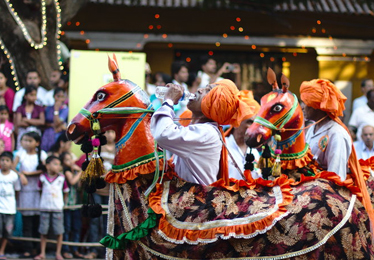14 Days of Shigmotsav
 14 Days of Shigmotsav
14 Days of Shigmotsav
The 14 days of Shigmotsav festival in Goan is celebrated with a lot of fanfare and fervour. It is celebrated in the month of Phalguna (March) from the 9th moon day to the full moon day according to the Hindu calendar. It is celebrated to bid adieu to winter and welcome spring. The festival commemorates the homecoming of the warriors who had left their homes and families at the end of Dusshera to fight the invaders. During Shigmo festival ripening of the winter crop is also included as a reason for the festivities. The Hindu traditions of the Goanese and mythology are exhibited through this spring festival.
This festival is a fusion between the Holi and the carnival. The main attraction of the 14 days of Shigmotsav festival is the spectacular parades comprising of street dancers, traditional folk and exquisitely and elaborately built floats depicting scenes from the regional mythology. There are two forms of the Shigmo festival, the DhaktoShigmo and the VhadloShigmo. The DhaktoShigmo is celebrated by the rural population, farmers and the labour class, whereas the VhadloShigmo is of greater importance and is celebrated by everyone.
This Goan spring festival is celebrated with much fanfaronade for a fortnight and different days are earmarked to be celebrated in different areas. The 14 days of Shigmotsav festival begins with Naman (song) and collective obeisance of the villagers. On the first day, the village deity is bathed and dressed in saffron robes. After the offering of food, a feast is held. 5th day of the festival is called Rang Panchami and is the real day of rejoicing. This day is celebrated much like the Hindu festival Holi, with “gulal”or red powder and the neel or blue colour.On the 11th to 15th moon day, the villagers set out with high spirit and festive mood, clad in vibrant, colourful attires and carrying toran or flags in their hands.
They also carry column-like, red spotted "dwajas”, and blowing flutes and beating drums to gather at the village temples, and dance in the temple court yard singing various folk songs to the beat of the drums.Shigmo celebrated in the temples of Phatarpya, Jambavali, Dhargale and Kansarpalare very famous in Goa and the neighbouring states and attract a large number of devotees and tourists.
By the time it is dusk, artists display the martial dances like 'Ghode-morni' or the horse dance and floats depicting the themes from ancient Hindu scriptures came to delight the crowd. The grand finale is marked by meticulously designed and beautifully adorned floats. These parades are held on a lesser scale in the cities Vasco, Margao, Ponda, and Mapusa.Naman and Jot are the songs sung in chorus during this festival. Various kinds of dances like the Talgadi, Lamp dance,Hanpet, Gopha,'Rommatamel' and 'Fugdi' dances are performed by the villagers as part of the festivity. Dhol and Taso are drums which are carried as accompaniments to the songs and dances performed. The 14 days of Shigmotsavare full of festivities with the performance of troupes in the form of parades and cultural dances. The streets in the towns,after dusk reverberate with the music of the dhol, the conches and drums as huge statues of mythological figures and vivacious, peppy coloursand spectacular light effects parade their waythrough the city inprize winning floats or processions.
The performers carry a plate containing money from door to door singing and dancing. They coax the donors for donation and sing their song Tali for appreciating the donors. The festival comes to an end with a collective, sacred bath called Mad Davarap. The last day of the festival is marked by the entry of a spirit known as Gadepadap, into the dancers. During the celebration of this festival, villagers abstain from alcohol and non-vegetarian food. The month of Phalgun or March, signifies the onset of what in Goa is called Shigmo and the Rang Panchami of this festival resembles the Hindu festival Holi.Celebrated usually by the general masses in close religious associations of religious rites, this festival of Shigmo is carried out with a lot of fanfaronade of drum beats and epic depictions of Mythological scenes. The 14 days of Shigmotsav festival is celebrated with zest, gusto and a lot of vibrancy.






